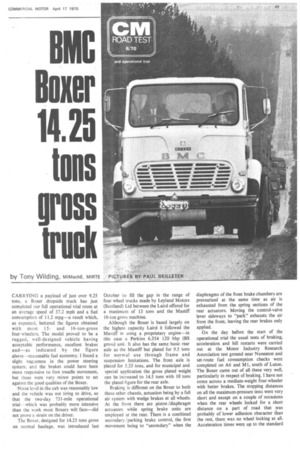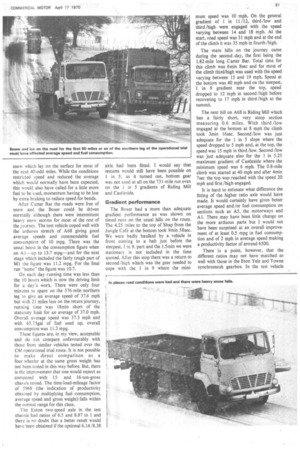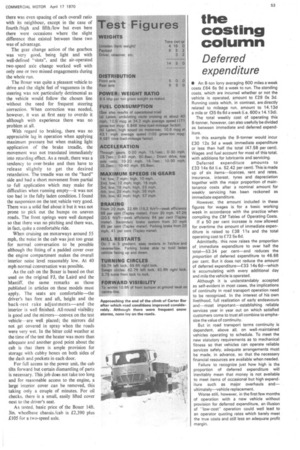by Tony Wilding, MIMechE, MIRTE PICTURES BY PAUL SKILLETER
Page 51

Page 52

Page 53

Page 55

If you've noticed an error in this article please click here to report it so we can fix it.
CARRYING a payload of just over 9.25 tons, a Boxer dropside truck has just completed our full operational trial route at an average speed of 37.2 mph and a fuel consumption of 11.2 mpg—a result which, as expected, bettered the figures obtained with most 15and 16-ton-gross four-wheelers. The model proved to be a rugged, well-designed vehicle having acceptable performance, excellent brakes and—as indicated by the figure above—reasonable fuel economy. I found a slight vagueness in the power steering system. and the brakes could have been more responsive to foot treadle movement, but these were very minor points to set against the good qualities of the Boxer.
Noise level in the cab was reasonably low and the vehicle was not tiring to drive, so that the two-day 731-mile operational trial which was probably more intensive than the work most Boxers will face—did not prove a strain on the driver.
The Boxer, designed for 14.25 tons gross on normal haulage, was introduced last
October to fill the gap in the range of four-wheel trucks made by Leyland Motors (Scotland) Ltd between the Laird offered for a maximum of 13 tons and the Mastiff 16-ton gross machine.
Although the Boxer is based largely on the highest capacity Laird it followed the Mastiff in using a proprietary engine—in this case a Perkins 6.354 120 bhp (BS gross) unit. It also has the same basic rear axle as the Mastiff but plated for 9.5 tons for normal use through frame and suspension limitations. The front axle is plated for 5.25 tons, and for municipal and special application the gross plated weight can be increased to 14.5 tons with 10 tons the plated figure for the rear axle.
Braking is different on the Boxer to both these other chassis, actuation being by a full air system with wedge brakes at all wheels. At the front there are piston /diaphragm actuators while spring brake units are employed at the rear. There is a combined secondary /parking brake control, the first movement being to "secondary" when the
diaphragms of the front brake chambers are pressurized at the same time as air is exhausted from the spring sections of the rear actuators. Moving the control-valve lever sideways to "park" exhausts the air from the front, leaving the rear brakes only applied.
On the day before the start of the operational trial the usual tests of braking, acceleration and hill restarts were carried out at the Motor Industry Research Association test ground near Nuneaton and set-route fuel consumption checks were completed on A6 and MI, south of Luton. The Boxer came out of all these very well, particularly in respect of braking. I have not come across a medium-weight four-wheeler with better brakes. The stopping distances on all the maximum-pressure tests were very short and except on a couple of occasions when the rear wheels locked for a short distance on a part of road that was probably of lower adhesion character than the rest, there was no wheel locking at all. Acceleration times were up to the standard one would expect of a vehicle with a power to weight ratio of just over 8 bhp per ton and the Boxer performed well on restart checks on the test hills at MIRA. Easy restarts were made in first /low and reverse/low when facing up and down respectively on the 1 in 5 gradient, and restarts were possible in the same gearbox ratios but with high axle ratio engaged on the 1 in 6.
On the set-route consumption checks the Boxer also gave a good account of itself with 12 mpg on the 6-mile out-and-return run on A6, south of Luton, and 10.9 mpg on the 15.8-mile run from the A6 to A4147 junctions on M1 and back.
Consumption checks The set-route consumption figures were confirmed on the operational trial and, in fact, exactly the same figure as on the high-speed test was returned on the first 207 miles of the journey to the Forton service r area. On the slower part of the first day's journey, from that point to Gretna, the figure was 11.2 mpg which is good considering that the 84 miles includes Shap and some fairly hilly country. Over the Tweedsmuir hills and the first 57 miles of A68 on the second day, consumption was very similar to that on the M1 /A5 /M6 section-10.8 mpg.
There must have been some effect from bad road conditions in this last figure. After the first day's run in pleasant weather, the southern leg was begun with icy rOads for four or five miles, soon to be followed by
snow which lay on the surface for most of the next 40-odd miles. While the conditions restricted speed and reduced the average which would normally have been expected, this would also have called for a little more fuel to be used, momentum having to be lost by extra braking to reduce speed for bends.
After Carter Bar the roads were free of snow and the Boxer could. be driven normally although there were intermittent heavy snow storms for most of the rest of the journey. The test vehicle coped well with the arduous stretch of A68 giving good average speeds and commendable fuel consumption of 10 mpg. There was the usual boost in the consumption figure when on Al —up to 13.7 mpg—and for the next stage which included the fairly tough part of M1 the figure was 11.2 mpg. For the final run "homethe figure was 10.7.
On each day running time was less than the 10 hours which is now the driving limit for a day's work. There were only four minutes to spare on the 376-mile northern leg to give an average speed of 37.6 mph but with 21 miles less on the return journey, running time was 18min short of the statutory Emit for an average of 37.0 mph. Overall average speed was 37.3 mph and with 65.75 gal of fuel used up, overall consumption was 11.2 mpg.
These figures are, in my view, acceptable and do not compare unfavourably with those from similar vehicles tested over the CM operational trial route. It is not possible to make direct comparison as a four-wheeler at the same gross weight has not been tested in this way before. But, there is the improvement that one would expect as compared with 15and 16-ton-gross chassis tested. The time-load-mileage factor of 5968 (the indication of productivity obtained by multiplying fuel consumption, average speed and gross weight) falls within the normal range for this class.
The Eaton two-speed axle in the test chassis had ratios of 6.5 and 8.87 to 1 and there is no doubt that a better result would have been obtained if the optional 6.14/8.38 axle, had been fitted. I would say that restarts would still have been possible on 1 in 5; as it turned out, bottom gear was not used at all on the 731-mile run even on the 1 in 5 gradients of Riding Mill and Castleside.
Gradient performance The Boxer had a more than adequate gradient performance as was shown on timed runs on the usual hills on the route. The 4.25 miles to the top of Shap from the Jungle Cafe at the bottom took 9min 58sec. We were badly baulked by a vehicle in front coming to a halt just before the steepest, I in 9, part and the 1.5min we were stationary is not included in the time quoted. After this stop there was a return to second /high which was the gear needed to cope with the I in 9 where the mini mum speed was 10 mph. On the general gradient of 1 in 11 /12, third /low and third/high were engaged with the speed varying between 14 and 18 mph. At the start, road speed was 31 mph and at the end of the climb it was 35 mph in fourth /high.
The main hills on the journey came during the second ,day, the first being the 1.82-mile long Carter Ear. Total time for this climb was 6min 8sec and for most of the climb third/high was used with the speed varying between 15 and 19 mph. Speed at the bottom was 40 mph and on the steepest, 1 in 9 gradient near the top, speed dropped to 12 mph in second/high before recovering to 17 mph in third /high at the summit.
The next hill on A68 is Riding Mill which has a fairly short, very steep section measuring 0.6 miles. With third /low engaged at the bottom at 8 mph the climb took 3min 16sec. Second/low was just adequate for the 1 in 5 slope where the speed dropped to 5 mph and, at the top, the speed was 15 mph in third /low. Second /low was just adequate. also for the 1 in 5.25 maximum gradient of Castleside where the minimum speed was 6 mph. The 0.8-mile climb was started at 40 mph and after 4min 7sec the top was reached with the speed 20 mph and first/high engaged.
It is hard to estimate what difference the fitting of the higher ratio axle would have made. It would certainly have given better average speed and/or fuel consumption on sections such as A5, the motorways and Al. There may have been little change on the more arduous parts' but I would not have been surprised at an overall improvement of at least 0.5 mpg in fuel consumption and of 2 mph in average speed making a productivity factor of around 6500.
There is a point, however, that the different ratios may not have matched so well with those in the Eton Yale and Towne synchromesh gearbox. In the test vehicle there was even spacing of each overall ratio with its neighbour, except in the case of fourth /high and fifth/low but even here there were occasions where the slight difference that existed between these two was of advantage.
The gear change action of the gearbox was very good, being light and with well-defined "slots", and the air-operated two-speed axle change worked well with only one or two missed engagements during the whole run.
The Boxer was quite a pleasant vehicle to drive and the slight feel of vagueness in the steering was not particularly detrimental as the vehicle would follow the chosen line without the need for frequent steering correction. When correction was needed, however, it was at first easy to overdo it although with experience there was no problem at all, With regard to braking, there was no appreciable lag in operation when applying maximum pressure but when making light application of the brake treadle, the movement was not translated immediately into retarding effect. As a result, there was a tendency to over-brake and then have to release slightly to get the desired retardation. The treadle was on the "hard" side and had a short movement from partial to full application which may make for difficulties when running empty—it was not too bad in the fully laden condition. I found the suspension on the test vehicle very good. There was a solid feel about it but it was not prone to pick out the bumps on uneven roads. The front springs were well damped so that there was no pitching and there was, in fact, quite a comfortable ride.
When cruising on motorways around 55 mph, the noise in the cab was just too great for normal conversation to be possible although the fitting of a padded cover over the engine compartment makes the overall interior noise level reasonably low. At 40 mph normal conversation was possible.
As the cab on the Boxer is based on that used on the original El, the Laird and the Mastiff, the same remarks as those published in articles on these models must apply. The seats are comfortable—the driver's has fore and aft, height and the back-rest rake adjustments--and the interior is well finished. All-round visibility is good and the mirrors—convex on the test vehicle are well placed; the mirrors did not get covered in spray when the roads were very wet. In the bitter cold weather at the time of the test the heater was more than adequate and another good point about the cab is that there is ample provision for storage with cubby boxes on both sides of the dash and pockets in each door.
For full access to the power unit, the cab tilts forward but certain dismantling of parts is necessary. This job does not take too long and for reasonable access to the engine, a large interior cover can be removed, this taking only a couple of minutes. For oil checks, there is a small, easily lifted cover next to the driver's seat.
As tested, basic price of the Boxer 14ft. 3M. wheelbase chassis/cab is £2,390 plus £105 for a two-speed axle.












































































































